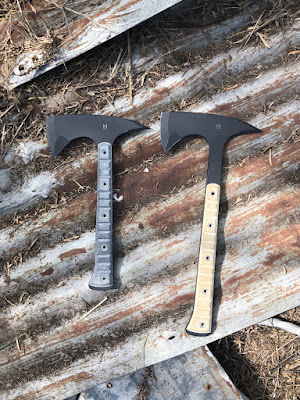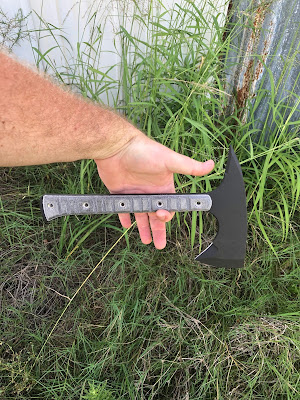Tactical Tomahawks:
06/15/2019 - There have been further changes made to tomahawks, and the prices have changed accordingly. Check out the changes in the "Tomahawk Stats" post.
To place an order or ask questions, send me an e-mail at helmgrind@gmail.com .
NOTE: It will be much quicker for you to purchase a tomahawk that is already in stock at one of my dealers than to place an order with me and wait for me to work my way down the list to you. If there is one in stock that matches what you want, I encourage you to snag it! Not to discourage orders, but my output is limited and it can take a while.
Dealers
NOTE: It will be much quicker for you to purchase a tomahawk that is already in stock at one of my dealers than to place an order with me and wait for me to work my way down the list to you. If there is one in stock that matches what you want, I encourage you to snag it! Not to discourage orders, but my output is limited and it can take a while.
Dealers
The final price depends on the options that you choose. If you answer the questions for me below, I know all of the options you want and can get your order added to my list quickly and easily. Otherwise, I end up having to coax the answers out of you over a series of e-mails.
The base price is for a Woodsman hammer poll tomahawk with an unsharpened inner beard, which is $250 plus shipping.
Adding a Wrecker pry spike is an additional $25. Adding a sharpened inner beard is an additional $25.
Length does not affect price, nor does color.
Your final price for just the 'hawk (no sheath or trainer) can range between $250 and $300 plus shipping.
If you order, answer these questions:
1. 12" version, 15" version, or 18" version. [18" versions on temporary hold]
2. Which model? Woodsman (hammer poll) or Wrecker (pry spike).
3. Sharpened inner beard or unsharpened.
4. Black, or desert tan for the handle slabs. NOTE: Olive drab is no longer an option.
5. Boltaron sheath or no. If yes, then answer the sheath questions further down the page.
6. Are you active duty military? If so, what branch? You go to the front of the line if you are. Law enforcement and first responders go right behind them.
Sheaths:
Sheaths are Boltaron, bottom eject, ambidextrous, MOLLE compatible, jump ready, with multiple carry options. The base price for a bare sheath with one retention strap of 1" wide nylon webbing and no carry hardware is $50. Each option will add to the total price. Please answer whether you want the following options or not.
1. Second retention strap. $5 The Boltaron itself retains the 'hawk just fine for general walking around, with the single retention strap mostly there in a precautionary role. Unless you are going to be jumping out of an airplane with your 'hawk strapped to your gear the second strap is probably overkill, but if you are jumping with it or are a belt-and-suspenders kind of guy, it's cheap insurance. Retention straps are adjustable for tightness.
2. Shoulder sling. $15 Each end of the strap has a slider that allows you to quickly adjust the 'hawk from riding at your waist to snug under the armpit. Quick-detach buckles mean that if you need to get the strap out of your way (going from hiking with it slung to riding in a vehicle, etc.), you can do so in seconds, then return it to a sling carry just as quickly. It also means that you can cinch the strap up tight under your arm for maximum clearance with your other gear and still take the 'hawk off quickly simply by opening the buckle on one end of the strap. The loops attaching the sling to the sheath can also double as belt loops, and are adjustable.
3. Pair of rubber IWB bands. $10 Loop over and snap shut with a pull-the-dot snap (http://www.dotfasteners.com/pull_the_dot.html). Mine are mounted so that they can be rotated from an up orientation to a down orientation. Work as belt loops or MOLLE attachment for quick attachment and detachment, while providing more flexibility in movement than MOLLE locks. Note: I do not recommend wearing an 18" model on your belt, as you'll likely have a bruised knee before you walk very far.
4. Pair of MOLLE locks. $14 Designed for attachment to standard MOLLE gear. Doesn't work well with a standard belt, but great on a MOLLE vest or pack (or one of those MOLLE tactical seat covers for your vehicle :D ). Holds more rigidly than IWB bands. Can be quickly detached and moved around on a MOLLE setup, but works well as a semi-permanent attachment point. Note: I see no point in having both MOLLE locks and IWB bands unless you plan on swapping between the two for some reason beyond my understanding. If you want both, I'll try to oblige you. :)
If ordering either IWB bands or MOLLE locks, please tell me whether you would rather have them mounted on the left side of the sheath or the right, as seen with the tomahawk held in front of you with the blade facing away from you. Otherwise, I will assume that it needs to be mounted on the left side, so that the 'hawk is carried on the right side with the edge forward.
Example setups:
MOLLE locks on the left, IWB bands on the right. Both have shoulder slings and single retention straps.
Double retention straps, shoulder sling, MOLLE locks.
Single retention strap, shoulder sling, IWB bands. Note that the second picture is how I plan on attaching all IWB bands in the future, where they can be rotated in either an up or down orientation.
Trainers:
Trainers are now available to order. They are waterjetted from 3/4" ABS plastic (same thickness as the handles on the real tomahawks), with all the edges beveled the same as the handles on the real 'hawks. They are the same profiles as the hammer poll tomahawks but with the corners rounded for safety. In addition, holes have been added to the heads allowing for the attachment of padding when sparring with a partner. These can easily crack a skull without it. Train safely and be considerate of your sparring partner!
These have the same handle cross section as the real 'hawks, with the same holes in the handles in case you want to train with a lanyard, and balance at the same points as the real 'hawks. They are a good deal lighter, as a wooden waster would be. Only hammer poll models are available as there is no way of making a spiked version that would be safe; even a very rounded spike would easily open a skull or penetrate the flesh of a torso with the kind of leverage these have. Although the hammer polls are 1 1/8" shorter than the spike models, they are long enough to practice hooking moves as you would with a spike.
Please specify whether you want a 12" model or 18" model.
Price (either length): $50 plus shipping









.JPG)
.JPG)
.JPG)







.JPG)
.JPG)
.JPG)
.JPG)

.JPG)
.JPG)
.JPG)
.JPG)
.JPG)
.JPG)
.JPG)
.JPG)
.JPG)
.JPG)
.JPG)
.JPG)
.JPG)
.JPG)
.JPG)